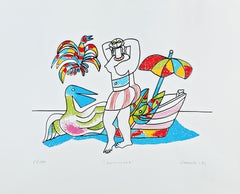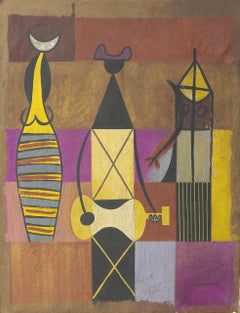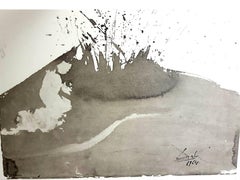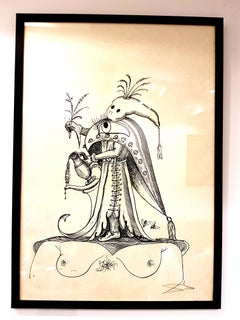Mario Carreno Art
to
1
2
1
1
1
1
1
Overall Height
to
Overall Width
to
1
1
1
1
2
1
1
2
6,996
3,377
2,513
1,212
1
1
1
1
1
Artist: Mario Carreno
Antillana
By Mario Carreno
Located in Miami, FL
Mario Carreño
"Antillana" 1993
Lithograph
64 of 120
18 x 23 in
Category
1990s Surrealist Mario Carreno Art
Materials
Lithograph
Personajes geométricos
By Mario Carreno
Located in Brooklyn, NY
Acquired from the Herminio Iglesias collection, Havana.
Category
1940s Abstract Geometric Mario Carreno Art
Materials
Canvas, Gouache, Laid Paper
Related Items
Salvador Dali - Biblia Sacra - Offset Lithograph
By Salvador Dalí
Located in Collonge Bellerive, Geneve, CH
Salvador Dali - The Biblia Sacra was published in 1969 by Rizzoli of Rome
- SIGNATURE : printed in the image
- LIMITED : 1499
- SIZE : 19 x 13 3/4"
- REFERENCES : Michler and Lopsi...
Category
1960s Surrealist Mario Carreno Art
Materials
Lithograph
Salvador Dali - Les Songes Drolatiques - Handsigned Lithograph
By Salvador Dalí
Located in Collonge Bellerive, Geneve, CH
Hand-Signed Lithograph by Salvador Dali
Japan Paper
Title: Pantagruel's Dreams
Signed in Pencil by Salvador Dali
Dimensions: 76 x 56 cm
Edition: EA
1973
References : Field 73-7 (p. 1...
Category
1970s Surrealist Mario Carreno Art
Materials
Lithograph
Salvador Dali - The Vision - Original Lithograph
By Salvador Dalí
Located in Collonge Bellerive, Geneve, CH
Salvador Dali - The Vision - Original Lithograph
Joseph FORET, Paris, 1957
PRINTER : Detruit.
SIGNATURE : plate signed by Dali.
LIMITED : 233 copies.
SIZE : 41 x 33 cm
REFERENCES ...
Category
1950s Surrealist Mario Carreno Art
Materials
Lithograph
Jean COCTEAU and Raymond MORETTI: Love Encounter - Original Hansigned Lithograph
By Jean Cocteau
Located in Paris, FR
Jean Cocteau and Raymond Moretti
Love Encounter
Original lithograph
Printed signature in the plate, handsigned by Raymond Moretti
Numbered EA 1/10 - Very look for proof bearing n°1
...
Category
1970s Surrealist Mario Carreno Art
Materials
Lithograph
Dalínean Prophecy
By Salvador Dalí
Located in Greenwich, CT
Dalínean Prophecy is a drypoint etching with lithographic color on japon paper, image size 16 x 23.5 inches, signed Dalí lower right and numbered XVIII/LXXV lower left. From the edit...
Category
20th Century Surrealist Mario Carreno Art
Materials
Drypoint, Lithograph
Salvador Dali - from Biblia Sacra - Offset Lithograph
By Salvador Dalí
Located in Collonge Bellerive, Geneve, CH
Salvador Dali - The Biblia Sacra was published in 1969 by Rizzoli of Rome
- SIGNATURE : printed in the image
- LIMITED : 1499
- SIZE : 19 x 13 3/4"
- REFERENCES : Michler and Lopsi...
Category
1960s Surrealist Mario Carreno Art
Materials
Lithograph
H 19 in W 13.75 in D 0.1 in
Specifically Nowhere, Yellow (Abstract Geometric Painting with Grids on Yellow)
By Donise English
Located in Hudson, NY
Large abstract geometric painting with intricate line work in pencil and gouache on a bright yellow background
"Specifically, Nowhere (Yellow)" made by Hudson Valley artist, Donise English, in 2022
gouache, acrylic, pencil, and colored pencil on paper, mounted on panel
48 x 48 inches unframed, 50 x 50 inches with a dark brown stained wood floater frame
Surface is protected with four coats of an archival UV protective varnish
Signed, verso
Excellent condition and ready to hang
This large abstract geometric painting was made by Hudson Valley based artist, Donise English, in 2022. The composition begins with a bright yellow background overlaid with intricate line work in graphite and colored pencil. Thousands of hand drawn lines serve as a backdrop for a bold geometric form in a dusty violet and dark gray gridded pattern that references "an imagined city grid", says the artist. The painting on paper is mounted to wood panel and complemented with a dark stained wood floater frame. It's in excellent condition and ready to hang as is. The surface is protected with four coats of an archival UV protective varnish.
More about the work:
Donise English emphasizes lines, grids, and fields of subtle color to evoke imagined places and invented structures. While precise lines and straight angles are often associated with themes in architecture and urban planning designs, English conveys a geometric motif guided by intuition rather than a ruler. Variations on grids retain flaws and unmistakable traces of the artists’ hand; her style of draftsmanship shies away from intellectualism and instead makes her compositions feel very personal. Each design is intensely intricate, incorporating gouache, acrylic, pen, graphite, ink and colored pencil.
Artist Statement:
My work is about the way visual diagrams present information that describes how something is made or the way it is. I am interested in drawing and collaging multiple layers of information that refer abstractly to maps, architectural drawings and blueprints or patterns and structures found in such things as roller coasters, power lines and fences. I use gouache and collaged paper in a series of layers that are a visual and ideological response to the previous layer to define my pictorial space. For each piece I create a set of rules to follow about the use of a limited palette, a grid format, opacity of paper and whether a piece may include curving lines or maintain a rectilinear structure.
Artist CV:
EDUCATION
Master of Fine Arts in Painting
Bard College 1986
Bachelor of Science in Art History
State University College at New Paltz 1977
Additional Study: New York Studio School (Drawing Marathons)
Columbia University, School of Architecture
Women’s Studio Workshop
TEACHING
Professor of Studio Art, Department of Art and Art History, Marist College, Poughkeepsie, NY
Coordinator, Interior Design Program, Florence, Italy campus
1992-present
AWARDS
NYFA Fellowship in Painting 2018
Invitational Award for Outstanding Contemporary Talent,
University of Bridgeport, CT 2000
Purchase Prize, “11th National Juried Exhibition”
College of Notre Dame of Maryland, Baltimore 1999
First Prize, “Women in the Visual Arts ‘95”
Erector Square Gallery, New Haven, CT 1995
Joseph A. Cain Memorial Purchase Award for Sculpture
Del Mar College, Corpus Christi, TX 1994
Honorable Mention, “National Juried Exhibition”
University of Bridgeport, CT 1993
Individual Artists Fellowship in Sculpture
Dutchess Arts Fund 1992/93
Tallix, Morris, Singer Internship in Sculpture
Tallix Foundry, Beacon, NY 1990/91
MEMBERSHIP Royal British Society of Sculptors
SELECTED JURIED/INVITATIONAL EXHIBITIONS
2020
“edu: Art Faculty of the Hudson Valley”, Hudson Valley MOCA, Peekskill, NY
2019
“Contemporary Abstraction”, Carrie Haddad Gallery, Hudson, NY
“Mixed Media”, SITE Gallery, Brooklyn, NY
2018
“JuxtaPositions”, The Painting Center, New York, NY
“Peculiar Rarities”, Carrie Haddad Gallery, Hudson, NY
2017
“Interlock: Color and Contrast in Abstraction”, Carrie Haddad Gallery, Hudson, NY
“Donise English: Encaustics”, Catskill Art Society, Livingston Manor, NY
2016
“Let’s Stay in Touch”, Howard County Center for the Arts, Ellicott City, MD
“Under, Over, After Over”, Vassar College, Poughkeepsie, NY
2015
“Off the Grid”, Arts & Culture Program, Albany International Airport, Albany, NY
“Gridspace”, KMOCA, Kingston, NY
“Abstraction”, Carrie Haddad Gallery, Hudson, NY
“Assuming Identity”, NY Institute of Technology, New York, NY
2013
“Modern Artists”, Carrie Haddad Gallery, Hudson, NY
“Artists of the Mohawk-Hudson Region”, The Hyde Collection, Glens Falls, NY
Stone Canoe/Community Folk Art Center, Syracuse, NY
2012
New York Institute of Technology, New York, NY
“Contemporary Painters (Who Just Happen To Be Women)”,
Carrie Haddad Gallery, Hudson, NY
“Strange Glue: Collage at 100”, Cambridge School, Weston, MA
“Dear Mother Nature”, Dorsky Museum, SUNY New Paltz, NY
“Fresher Paint”, Rockland Center for the Arts, Nyack, NY
Courthouse Gallery, Lake George Arts Project, Lake George, NY
2011
“Process+Content: Donise English”, Vassar College, Poughkeepsie, NY “Donise English-Paintings”,Orange County Community College,
Newburgh, NY
“Gender Matters/Matters of Gender”, Freedman Gallery,
Albright College, Reading, PA
2010
Carrie Haddad Gallery, Hudson, NY
“Encaustics: Wax and Image”, Westchester Community College,
White Plains, NY
“Dots, Lines and Figures”, Carrie Haddad Gallery, Hudson, NY
“Spring Awakening”, NY Institute of Technology, New York, NY
“Clay City Dreams”, NY Institute of Technology, New York, NY
“Texture,Pattern, Fragment”, Krause Gallery, Moses Brown School,
Providence, RI
2009
“Collage”, NY Institute of Technology, New York, NY
“Working in Wax”, Bedford Gallery, Walnut Creek, CA
“Encaustic 2009”, College of New Rochelle, NY
“Three Artists”, Carrie Haddad Gallery, Hudson, NY
“Convergence: The Human Experience”,Howard County Center for the Arts, MD
2008
“Suckers and Biters: Love, Lollipops, and Exquisite Corpse”
Chashama Gallery, New York, NY
Carrie Haddad Gallery, Hudson NY
2007
“Patterns and Light”, Blue Hill Gallery, Blue Hill, ME
“Suckers and Biters”, AG Gallery, Brooklyn, NY
2006
“100 Artists, 100 Watercolors”, Jeannie Freilich Fine Art,
New York, NY
“On/Of Paper”,Kirkland Art Center, Clinton, NY
“The Love Show”, Manchester Community College, Manchester, CT
2005
The Soap Factory, Minneapolis, MN
“Small Tales”, Valdosta State University, Georgia
National Juried Exhibition,Art Institute and Gallery
Salisbury, MD, Juror: Stephen Haller
“Greed, Envy, Jealousy, Fear”, TSL Warehouse, Hudson, NY
2004
“Women in the Middle: Borders, Barriers, Intersections”
University of Wisconsin-Milwaukee
“Girl Art Now”,Hera Gallery, Wakefield, RI
3 Person Exhibition, Monterey Peninsula College, Monterey, CA
“The Feminine Eye”, Bradley University, Peoria, IL “Women Painting Women”, McNeese State University, Lake Charles, LA “Thought Patterns”, Kent Place Gallery, Summit, NJ “Surface, Matter and Artifice”, Dutchess Community College Art Gallery
Poughkeepsie, NY
2003
“Beefcake/Cheesecake”,Orange County Center for Contemporary Art,
Santa Ana, CA,Juror: Jamie Wilson, Curator
Halpert Bienniel, Appalachian State University, Boone, NC
Juror: Jeff Fleming, Senior Curator, Des Moines Art Center “The Great White Oak”, Garrison Art Center, Garrison, NY Carrie Haddad Gallery, Hudson, NY
2002
“Cat Calls”, Red Clay Arts, Brooklyn
“Hudson Valley Regional”, SUNY New Paltz
Juror: Sydney Jenkins, Director, Ramapo College Art Galleries
2001
One-Person Exhibition, Davis and Hall Gallery, Hudson, NY “Beyond the Surface”, Womanmade Gallery, Chicago
One-Person Exhibition, Garrison Art Center, Garrison, NY
2000
“Vision 2000...
Category
2010s Abstract Geometric Mario Carreno Art
Materials
Canvas, Gouache, Archival Paper, Color Pencil, Graphite
Salvador Dali - from Biblia Sacra - Offset Lithograph
By Salvador Dalí
Located in Collonge Bellerive, Geneve, CH
Salvador Dali - The Biblia Sacra was published in 1969 by Rizzoli of Rome
- SIGNATURE: printed in the image
- EDITION: 1499
- SIZE : 19 x 13 3/4"
- REFERENCES: Michler and Lopsinge...
Category
1960s Surrealist Mario Carreno Art
Materials
Lithograph
H 19 in W 13.75 in D 0.1 in
Minoan Abstract
By Sasha Rogers
Located in Soquel, CA
Beautiful textural abstract by Sasha Rogers (Canadian, 20th/21st Century). Signed "Sasha S. Rogers '91", titled "Minoan" on verso. Two identifying labels on verso. Displayed in a sla...
Category
1990s Abstract Geometric Mario Carreno Art
Materials
Canvas, Acrylic, Gouache
Marc Chagall - Original Lithograph
By Marc Chagall
Located in Collonge Bellerive, Geneve, CH
Marc Chagall
Original Lithograph
1963
Dimensions: 32 x 24 cm
Reference: Chagall Lithographe 1957-1962. VOLUME II.
Condition : Excellent
Marc Chagall (born in 1887)
Marc Chagall was born in Belarus in 1887 and developed an early interest in art. After studying painting, in 1907 he left Russia for Paris, where he lived in an artist colony on the city’s outskirts. Fusing his own personal, dreamlike imagery with hints of the fauvism and cubism popular in France at the time, Chagall created his most lasting work—including I and the Village (1911)—some of which would be featured in the Salon des Indépendants exhibitions. After returning to Vitebsk for a visit in 1914, the outbreak of WWI trapped Chagall in Russia. He returned to France in 1923 but was forced to flee the country and Nazi persecution during WWII. Finding asylum in the U.S., Chagall became involved in set and costume design before returning to France in 1948. In his later years, he experimented with new art forms and was commissioned to produce numerous large-scale works. Chagall died in St.-Paul-de-Vence in 1985.
The Village
Marc Chagall was born in a small Hassidic community on the outskirts of Vitebsk, Belarus, on July 7, 1887. His father was a fishmonger, and his mother ran a small sundries shop in the village. As a child, Chagall attended the Jewish elementary school, where he studied Hebrew and the Bible, before later attending the Russian public school. He began to learn the fundamentals of drawing during this time, but perhaps more importantly, he absorbed the world around him, storing away the imagery and themes that would feature largely in most of his later work.
At age 19 Chagall enrolled at a private, all-Jewish art school and began his formal education in painting, studying briefly with portrait artist Yehuda Pen. However, he left the school after several months, moving to St. Petersburg in 1907 to study at the Imperial Society for the Protection of Fine Arts. The following year, he enrolled at the Svanseva School, studying with set designer Léon Bakst, whose work had been featured in Sergei Diaghilev's Ballets Russes. This early experience would prove important to Chagall’s later career as well.
Despite this formal instruction, and the widespread popularity of realism in Russia at the time, Chagall was already establishing his own personal style, which featured a more dreamlike unreality and the people, places and imagery that were close to his heart. Some examples from this period are his Window Vitebsk (1908) and My Fianceé with Black Gloves (1909), which pictured Bella Rosenfeld, to whom he had recently become engaged.
The Beehive
Despite his romance with Bella, in 1911 an allowance from Russian parliament member and art patron Maxim Binaver enabled Chagall to move to Paris, France. After settling briefly in the Montparnasse neighborhood, Chagall moved further afield to an artist colony known as La Ruche (“The Beehive”), where he began to work side by side with abstract painters such as Amedeo Modigliani and Fernand Léger as well as the avant-garde poet Guillaume Apollinaire. At their urging, and under the influence of the wildly popular fauvism and cubism, Chagall lightened his palette and pushed his style ever further from reality. I and the Village (1911) and Homage to Apollinaire (1912) are among his early Parisian works, widely considered to be his most successful and representative period.
Though his work stood stylistically apart from his cubist contemporaries, from 1912 to 1914 Chagall exhibited several paintings at the annual Salon des Indépendants exhibition, where works by the likes of Juan Gris, Marcel Duchamp and Robert Delaunay were causing a stir in the Paris art world. Chagall’s popularity began to spread beyond La Ruche, and in May 1914 he traveled to Berlin to help organize his first solo exhibition, at Der Sturm Gallery. Chagall remained in the city until the highly acclaimed show opened that June. He then returned to Vitebsk, unaware of the fateful events to come.
War, Peace and Revolution
In August 1914 the outbreak of World War I precluded Chagall’s plans to return to Paris. The conflict did little to stem the flow of his creative output, however, instead merely giving him direct access to the childhood scenes so essential to his work, as seen in paintings such as Jew in Green (1914) and Over Vitebsk (1914). His paintings from this period also occasionally featured images of the war’s impact on the region, as with Wounded Soldier (1914) and Marching (1915). But despite the hardships of life during wartime, this would also prove to be a joyful period for Chagall. In July 1915 he married Bella, and she gave birth to a daughter, Ida, the following year. Their appearance in works such as Birthday (1915), Bella and Ida by the Window (1917) and several of his “Lovers” paintings give a glimpse of the island of domestic bliss that was Chagall’s amidst the chaos.
To avoid military service and stay with his new family, Chagall took a position as a clerk in the Ministry of War Economy in St. Petersburg. While there he began work on his autobiography and also immersed himself in the local art scene, befriending novelist Boris Pasternak, among others. He also exhibited his work in the city and soon gained considerable recognition. That notoriety would prove important in the aftermath of the 1917 Russian Revolution when he was appointed as the Commissar of Fine Arts in Vitebsk. In his new post, Chagall undertook various projects in the region, including the 1919 founding of the Academy of the Arts. Despite these endeavors, differences among his colleagues eventually disillusioned Chagall. In 1920 he relinquished his position and moved his family to Moscow, the post-revolution capital of Russia.
In Moscow, Chagall was soon commissioned to create sets and costumes for various productions at the Moscow State Yiddish Theater...
Category
1960s Surrealist Mario Carreno Art
Materials
Lithograph
Marc Chagall - Original Lithograph
By Marc Chagall
Located in Collonge Bellerive, Geneve, CH
Marc Chagall
Original Lithograph
1963
Dimensions: 32 x 24 cm
Reference: Chagall Lithographe 1957-1962. VOLUME II.
Unsigned edition of over 5,000
Condition : Excellent
Marc Chagall (born in 1887)
Marc Chagall was born in Belarus in 1887 and developed an early interest in art. After studying painting, in 1907 he left Russia for Paris, where he lived in an artist colony on the city’s outskirts. Fusing his own personal, dreamlike imagery with hints of the fauvism and cubism popular in France at the time, Chagall created his most lasting work—including I and the Village (1911)—some of which would be featured in the Salon des Indépendants exhibitions. After returning to Vitebsk for a visit in 1914, the outbreak of WWI trapped Chagall in Russia. He returned to France in 1923 but was forced to flee the country and Nazi persecution during WWII. Finding asylum in the U.S., Chagall became involved in set and costume design before returning to France in 1948. In his later years, he experimented with new art forms and was commissioned to produce numerous large-scale works. Chagall died in St.-Paul-de-Vence in 1985.
The Village
Marc Chagall was born in a small Hassidic community on the outskirts of Vitebsk, Belarus, on July 7, 1887. His father was a fishmonger, and his mother ran a small sundries shop in the village. As a child, Chagall attended the Jewish elementary school, where he studied Hebrew and the Bible, before later attending the Russian public school. He began to learn the fundamentals of drawing during this time, but perhaps more importantly, he absorbed the world around him, storing away the imagery and themes that would feature largely in most of his later work.
At age 19 Chagall enrolled at a private, all-Jewish art school and began his formal education in painting, studying briefly with portrait artist Yehuda Pen. However, he left the school after several months, moving to St. Petersburg in 1907 to study at the Imperial Society for the Protection of Fine Arts. The following year, he enrolled at the Svanseva School, studying with set designer Léon Bakst, whose work had been featured in Sergei Diaghilev's Ballets Russes. This early experience would prove important to Chagall’s later career as well.
Despite this formal instruction, and the widespread popularity of realism in Russia at the time, Chagall was already establishing his own personal style, which featured a more dreamlike unreality and the people, places and imagery that were close to his heart. Some examples from this period are his Window Vitebsk (1908) and My Fianceé with Black Gloves (1909), which pictured Bella Rosenfeld, to whom he had recently become engaged.
The Beehive
Despite his romance with Bella, in 1911 an allowance from Russian parliament member and art patron Maxim Binaver enabled Chagall to move to Paris, France. After settling briefly in the Montparnasse neighborhood, Chagall moved further afield to an artist colony known as La Ruche (“The Beehive”), where he began to work side by side with abstract painters such as Amedeo Modigliani and Fernand Léger as well as the avant-garde poet Guillaume Apollinaire. At their urging, and under the influence of the wildly popular fauvism and cubism, Chagall lightened his palette and pushed his style ever further from reality. I and the Village (1911) and Homage to Apollinaire (1912) are among his early Parisian works, widely considered to be his most successful and representative period.
Though his work stood stylistically apart from his cubist contemporaries, from 1912 to 1914 Chagall exhibited several paintings at the annual Salon des Indépendants exhibition, where works by the likes of Juan Gris, Marcel Duchamp and Robert Delaunay were causing a stir in the Paris art world. Chagall’s popularity began to spread beyond La Ruche, and in May 1914 he traveled to Berlin to help organize his first solo exhibition, at Der Sturm Gallery. Chagall remained in the city until the highly acclaimed show opened that June. He then returned to Vitebsk, unaware of the fateful events to come.
War, Peace and Revolution
In August 1914 the outbreak of World War I precluded Chagall’s plans to return to Paris. The conflict did little to stem the flow of his creative output, however, instead merely giving him direct access to the childhood scenes so essential to his work, as seen in paintings such as Jew in Green (1914) and Over Vitebsk (1914). His paintings from this period also occasionally featured images of the war’s impact on the region, as with Wounded Soldier (1914) and Marching (1915). But despite the hardships of life during wartime, this would also prove to be a joyful period for Chagall. In July 1915 he married Bella, and she gave birth to a daughter, Ida, the following year. Their appearance in works such as Birthday (1915), Bella and Ida by the Window (1917) and several of his “Lovers” paintings give a glimpse of the island of domestic bliss that was Chagall’s amidst the chaos.
To avoid military service and stay with his new family, Chagall took a position as a clerk in the Ministry of War Economy in St. Petersburg. While there he began work on his autobiography and also immersed himself in the local art scene, befriending novelist Boris Pasternak, among others. He also exhibited his work in the city and soon gained considerable recognition. That notoriety would prove important in the aftermath of the 1917 Russian Revolution when he was appointed as the Commissar of Fine Arts in Vitebsk. In his new post, Chagall undertook various projects in the region, including the 1919 founding of the Academy of the Arts. Despite these endeavors, differences among his colleagues eventually disillusioned Chagall. In 1920 he relinquished his position and moved his family to Moscow, the post-revolution capital of Russia.
In Moscow, Chagall was soon commissioned to create sets and costumes for various productions at the Moscow State Yiddish...
Category
1960s Surrealist Mario Carreno Art
Materials
Lithograph
Strange Rider from Carnival of St. Petersburg Suite by Mihail Chemiakin
By Mihail Chemiakin
Located in Long Island City, NY
Artist: Mihail Chemiakin, Russian (1943 - )
Title: Strange Rider from Carnival of St. Petersburg Suite
Year: Circa 1980
Medium: Lithograph, signed and numbered in pencil
Edition: 30...
Category
1980s Surrealist Mario Carreno Art
Materials
Lithograph
Mario Carreno art for sale on 1stDibs.
Find a wide variety of authentic Mario Carreno art available for sale on 1stDibs. You can also browse by medium to find art by Mario Carreno in canvas, fabric, gouache and more. Much of the original work by this artist or collective was created during the 20th century and is mostly associated with the Surrealist style. Not every interior allows for large Mario Carreno art, so small editions measuring 22 inches across are available. Customers who are interested in this artist might also find the work of Carmen Herrera, Ron Agam, and Yuri Martinez Ramos. Mario Carreno art prices can differ depending upon medium, time period and other attributes. On 1stDibs, the price for these items starts at $1,500 and tops out at $20,000, while the average work can sell for $10,750.



